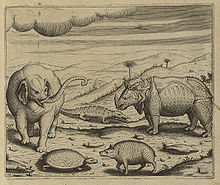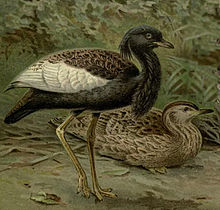Orang National Park
It is rich in flora and fauna, including great Indian rhinoceros, pygmy hog, Asian elephant, wild water buffalo and the Bengal tiger.
The game reserve came under the control of the wildlife wing of the State Forest Department to meet the requirements of Project Tiger.
[1] Orang National Park encompasses an area of 78.81 km2 (30.43 sq mi) and lies on the north bank of the Brahmaputra River within the districts of Darrang and Sonitpur.
[2] The park is thus formed of alluvial flood plains of the many rivers and is an integral part of the Indo-Burma hotspot of biodiversity.
The pygmy hog, a small wild pig, is critically endangered, C2a(ii) ver 3.1 as per IUCN listing, and is limited to about 75 animals in captivity, confined to a very few locations in and around north-western Assam, including the Orang National Park where it has been re-introduced.
[clarify] So far, 222 bird species have been recorded, some of which are: spot-billed pelican (Pelicanus philippensis), great white pelican, black-necked stork (Ephippiorhynchus asiaticus), greater adjutant stork (Leptoptilos dubius), lesser adjutant stork (Leptoptilos javanicus), ruddy shelduck (Tadorna ferruginea), gadwall (Anas strepera), brahminy duck, mallard (Anas platyrhynchos), pintail (Anas acuta), hornbills, Pallas's fish eagle (Haliaeetus leucoryphus), king fisher and woodpecker, in addition to forest and grassland birds.
A population of 30−40 individuals was recorded in the park by the Bombay Natural History Society (BNHS) in 1990; this was the second highest concentration of the species, globally.
The forest species found are: Bombax ceiba, Dalbergia sissoo, Sterculia villosa, Trewia nudiflora, Ziziphus jujuba and Litsea monopetala (syn.
Among the non-aquatic grassland species, the prominent are: Phragmites karka, Arundo donax, Imperata cylindrica and Saccharum spp.
[3][8][4][12] From 1991, there was a serious threat to the survival of the park and its wild animals due to intense anthropogenic pressure— including illegal occupation by immigrants from the neighbouring country[citation needed] and encroachment from agriculture and forest resource harvesting by local populations dependent for their livelihoods on such practices[13] —and by insurgency.
WWF India, the Government of Assam and the International Rhino Foundation (IRF), with support from Zoo Basel, (Switzerland) and the IRV 2020, have undertaken this operation.
[14] Since royal Bengal tigers are also under serious threat in the park, a conservation programme sponsored by WAZA (World Association of Zoos and Aquariums) institutions and Busch Gardens has been launched.
With this funding, camera traps and geo-spatial technology are used by local researchers to monitor tiger density in the park.


